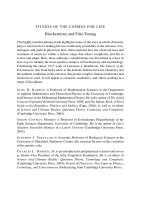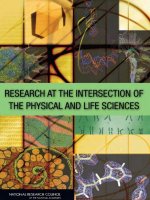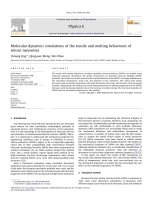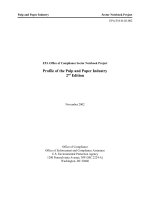Evolution s destiny evolving chemistry of the invironment and life
Bạn đang xem bản rút gọn của tài liệu. Xem và tải ngay bản đầy đủ của tài liệu tại đây (38.53 MB, 344 trang )
R. J. P. Williams and R. E. M. Rickaby
Evolution’s Destiny
Co-evolving Chemistry of the Environment and Life
Evolution’s Destiny
Co-evolving Chemistry of the Environment and Life
RSC Nanoscience & Nanotechnology
Series Editors:
Professor Paul O’Brien, University of Manchester, UK
Professor Sir Harry Kroto FRS, University of Sussex, UK
Professor Ralph Nuzzo, University of Illinois at Urbana-Champaign, USA
Titles in the Series:
1: Nanotubes and Nanowires
2: Fullerenes: Principles and Applications
3: Nanocharacterisation
4: Atom Resolved Surface Reactions: Nanocatalysis
5: Biomimetic Nanoceramics in Clinical Use: From Materials to Applications
6: Nanofluidics: Nanoscience and Nanotechnology
7: Bionanodesign: Following Nature’s Touch
8: Nano-Society: Pushing the Boundaries of Technology
9: Polymer-based Nanostructures: Medical Applications
10: Metallic and Molecular Interactions in Nanometer Layers, Pores and
Particles: New Findings at the Yoctolitre Level
11: Nanocasting: A Versatile Strategy for Creating Nanostructured Porous
Materials
12: Titanate and Titania Nanotubes: Synthesis, Properties and Applications
13: Raman Spectroscopy, Fullerenes and Nanotechnology
14: Nanotechnologies in Food
15: Unravelling Single Cell Genomics: Micro and Nanotools
16: Polymer Nanocomposites by Emulsion and Suspension
17: Phage Nanobiotechnology
18: Nanotubes and Nanowires: 2nd Edition
19: Nanostructured Catalysts: Transition Metal Oxides
20: Fullerenes: Principles and Applications, 2nd Edition
21: Biological Interactions with Surface Charge Biomaterials
22: Nanoporous Gold: From an Ancient Technology to a High-Tech Material
23: Nanoparticles in Anti-Microbial Materials: Use and Characterisation
How to obtain future titles on publication:
A standing order plan is available for this series. A standing order will bring
delivery of each new volume immediately on publication.
For further information please contact:
Book Sales Department, Royal Society of Chemistry, Thomas Graham House,
Science Park, Milton Road, Cambridge, CB4 0WF, UK
Telephone: +44 (0)1223 420066, Fax: +44 (0)1223 420247, Email: books@
rsc.org
Visit our website at />
Evolution’s Destiny
Co-evolving Chemistry of the Environment
and Life
R. J. P. Williams
Inorganic Chemistry Laboratory, University of Oxford, Oxford, OX1 3QR UK
Email:
R. E. M. Rickaby
Department of Earth Sciences, University of Oxford, Oxford, OX1 3AN UK
Email:
ISBN: 978-1-84973-558-2
A catalogue record for this book is available from the British Library
# R. J. P. Williams and R. E. M. Rickaby 2012
All rights reserved
Apart from fair dealing for the purposes of research for non-commercial purposes
or for private study, criticism or review, as permitted under the Copyright,
Designs and Patents Act 1988 and the Copyright and Related Rights Regulations
2003, this publication may not be reproduced, stored or transmitted, in any form
or by any means, without the prior permission in writing of The Royal Society of
Chemistry or the copyright owner, or in the case of reproduction in accordance
with the terms of licences issued by the Copyright Licensing Agency in the UK, or
in accordance with the terms of the licences issued by the appropriate
Reproduction Rights Organization outside the UK. Enquiries concerning
reproduction outside the terms stated here should be sent to The Royal Society
of Chemistry at the address printed on this page.
The RSC is not responsible for individual opinions expressed in this work.
Published by The Royal Society of Chemistry,
Thomas Graham House, Science Park, Milton Road,
Cambridge CB4 0WF, UK
Registered Charity Number 207890
For further information see our web site at www.rsc.org
Printed and bound in Great Britain by CPI Group (UK) Ltd, Croydon, CR0 4YY, UK
Preface
This book is written as an addition both to Darwin’s work and that of
molecular biologists on evolution, so as to include views from the point of view
of chemistry rather than just from our knowledge of the biology and genes of
organisms. By concentrating on a wide range of chemical elements, not just
those in traditional organic compounds, we show that there is a close
relationship between the geological or environmental chemical changes from
the formation of Earth and those of organisms from the time of their origin.
These are considerations that Darwin or other scientists could not have
explored until very recent times because sufficient analytical data were not
available. They lead us to suggest that there is a combined geo- and
biochemical evolution, that of an ecosystem, which has had a systematic
chemical development. In this development the arrival of new very similar
species is shown to be by random Darwinian competitive selection processes
such that a huge variety of species coexist with only minor differences in
chemistry and advantages, which is in agreement with previous studies. By way
of contrast, we observe that on a large scale, groups of such species have
special, different energy and chemical features and functions so that in fair part
they support one another. It is more difficult to understand how they evolved
and therefore we examine their energy and chemical development in detail.
Overall we know that there is a cooperative evolution of a chemical system
driven by capture of energy, mainly from the Sun, and its degradation, in
which the chemistry of both the environment and organisms are facilitating
intermediates. We will suggest that the overall drive of the whole joint system is
to optimise the rate of this energy degradation. The living part of the system,
the organisms, is under the influence of inevitable inorganic environmental
change which moves rapidly to equilibrium conditions, though much of it was
forced by the different chemicals added to it by organisms at different times.
We are also able to explore some ways in which the organic chemicals of
Evolution’s Destiny: Co-evolving Chemistry of the Environment and Life
R. J. P. Williams and R. E. M. Rickaby
# R. J. P. Williams and R. E. M. Rickaby 2012
Published by the Royal Society of Chemistry, www.rsc.org
v
vi
Preface
organisms evolved. Such evolution was dependent on the inevitably changing
environment for all its chemicals and therefore much novel organic chemistry
followed a determined path. We recognise that as complexity of the chemistry
of organisms increased, the organisms had to become part of a cooperative
overall activity and could not remain as isolated species. Prokaryotes and
bacteria managed by long-distance exchange between different cells; eukaryotes evolved by incorporating some bacteria – the organelles. The eukaryotes
also had increasing numbers of other compartments found in both animals and
plants. Later division of essential activities was by direct combination of
differentiated cells and by further different forms of symbiosis. Only in the last
chapter do we attempt to make a connection between the changing chemistry
of organisms with the coded molecules, DNA, of each cell which have to exist
to explain reproduction.
This book has to encompass the full spectrum of chemistry, from the
extreme of Earth Sciences to those of Biological Sciences. No author can claim
to cover all these disciplines to an appropriate depth. The authors of this book
apologise for misjudgements of any particular topics and trust that readers will
inform them of any errors.
Acknowledgements
We are indebted to the University of Oxford and to the Royal Society for
support. We are also grateful to Susie Compton for her help in typing the
documents and David Sansom for the illustrations. RR acknowledges financial
support from the ERC, grant SP2-GA-2008-200915.
Evolution’s Destiny: Co-evolving Chemistry of the Environment and Life
R. J. P. Williams and R. E. M. Rickaby
# R. J. P. Williams and R. E. M. Rickaby 2012
Published by the Royal Society of Chemistry, www.rsc.org
vii
Contents
Glossary
xv
Abbreviations
xix
About the Authors
xxi
Chapter 1
Outline of the Main Chemical Factors in Evolution
1.1
Introduction to the Chemistry of the Ecosystem
1.1.1 The Involvement of the Elements in Evolution
1.2 Equilibrium and Steady State Conditions
1.3 Solubility
1.4 Complex Ion Formation
1.5 Standard Oxidation/Reduction Potentials
1.6 Rate Controls and Catalysis
1.7 The Dangers of Catalysis
1.8 Diffusion
1.9 Irreversibility, Chaos and Predictability
1.10 Summary
References
Chapter 2
1
4
10
14
15
17
20
26
27
28
29
31
Geological Evolution with Some Biological Intervention
2.1
2.2
2.3
Introduction
Physical Evolution from the Earliest Times to Today
The Value of Isotope Studies: Indicators of Chemical
Changes and Geochemical Dates
Evolution’s Destiny: Co-evolving Chemistry of the Environment and Life
R. J. P. Williams and R. E. M. Rickaby
# R. J. P. Williams and R. E. M. Rickaby 2012
Published by the Royal Society of Chemistry, www.rsc.org
ix
32
33
39
x
Contents
2.4
The Early Chemical Development of the Environment
before 3.0 Ga
2.5 Energy Capture and Surface Geochemical Changes:
The Beginning of Organic Chemistry and Oxygen in
the Atmosphere
2.6 The Environment after 3.0 Ga: Revolution in Redox
Chemistry before 0.54 Ga
2.7 Sulfur Isotope Fractionation from 3.5 to 0.5 Ga;
Dominance of Iron/Sulfur Buffering
2.8 Evolving Mineral Outputs from the Ocean: Further
Evidence for Redox Chemistry before 0.54 Ga
2.8.1 Banded Iron Formations and the State of Iron
in Solution
2.8.2 Uranium and Thorium Minerals
2.9 Quantitative Analysis of Oxidation Conditions
2.10 Geochemical Changes of Trace Elements
2.10.1 Rare Earth Probes of the Environment
2.10.2 Trace Transition Metals in the Sea
2.11 The Non-Uniform Sea
2.12 Summary of Weathering from 3.5 Ga to 0.75 Ga
2.12.1 Weathering and Chemical Conditions from
0.75 Ga
2.12.2 Changes in Major Non-Redox Mineral
Elements in the Sea from 0.54 Ga
2.12.3 Carbon Isotopes
2.12.4 Oxygen Isotopes
2.13 Summary of Geological ‘Inorganic’ Chemistry
Evolution
2.14 A Note: The Relationship between Metal Structures
in Organisms, Minerals and Chemical Models
References
Chapter 3
40
42
45
48
49
49
49
50
52
52
54
57
58
60
63
65
66
67
70
71
Organism Development from the Fossil Record and the
Chemistry of the Nature of Biominerals
3.1
3.2
3.3
3.4
3.5
3.6
3.7
Introduction
The Fossil Record
Extinctions
Types of Biominerals
The Chemistry of Biominerals: The Handling of
Inorganic Elements
The Chemistry of Biominerals: Organic Components,
Composites
Shape of Organisms and Biominerals and Genetics
73
75
82
84
87
89
91
Contents
xi
3.8
Induced and Controlled Biomineralisation and
Genetics
3.9 Molecular Fossils
3.10 Carbon and Carbon/Hydrogen Deposits
3.11 Sulfur Deposits
3.12 Conclusions
3.13 Note
References
Chapter 4
92
94
94
96
96
98
98
Cells: Their Basic Organic Chemistry and their Environment
4.1
4.2
4.3
4.4
4.5
4.6
4.7
4.8
4.9
4.10
4.11
4.12
4.13
4.14
4.15
4.16
4.17
4.18
4.19
4.20
Introduction
The Proposed Beginnings of Life: Anaerobic
Prokaryotes
4.2.1 Energy Transduction and Use
Major Features of the Original Anaerobic Organic
Chemistry
The Genome and the Proteome: Concentration Terms
and Controls of Expression
4.4.1 Differences between Anaerobic Cell Types
Internal Structure of Prokaryotes and Production of
New Proteins
4.5.1 Prokaryote Cell Walls and Membranes
The Essence of the Chemistry of Anaerobic Life
4.6.1 A Note on Prokaryote Diversity
Resources and the Coming of Oxygen: Micro-Aerobic
and Aerobic Prokaryotes
The Single-Cell Eukaryotes
The Eukaryote Cell Nucleus
Filaments in Single-Cell Eukaryotes
Vesicles in Single-Cell Eukaryotes
Protection in Single-Cell Eukaryotes
Genetic Analysis of Unicellular Eukaryotes: Algae
and Metazoans
Summary of the Evolution of Unicellular Eukaryotes
The Multicellular Eukaryotes
The Evolution of the Divisions in Space in
Multicellular Organisms
Control of Growth and Shapes
Building Larger Structures: Internal and Extracellular
Tissue Proteins
The Evolution of Biominerals and their Associated
Structures
Extracellular Fluids
100
104
105
110
115
119
120
121
122
125
125
130
135
137
137
138
139
141
142
146
147
148
151
152
xii
Contents
4.21
Signalling with Organic Molecules and Electrolytic
Gradients in Multicellular Eukaryotes
4.22 Genetic Analysis of Multicellular Animals
4.23 Loss of Genes and Organism Collaboration: Internal
and External Symbiosis
4.24 Summary of the Distinctive Features of Biological
Organic Chemistry
References
Chapter 5
156
157
163
Other Major Elements in Organism Evolution
5.1
5.2
5.3
5.4
Introduction
Phosphorus in Cells
Sulfur in Cells
An Introduction to Magnesium, Calcium and Silicon
Chemistry in Organisms
5.5 Magnesium in Cells
5.6 Calcium in Organisms
5.7 Introduction to Signalling
5.7.1 Detailed Calcium Protein Signalling and its
Evolution in Eukaryotes
5.7.2 Weaker Binding Sites in Vesicles
5.8 Sodium/Potassium Messages
5.9 The Evolution of Biominerals
5.10 Calcium and Phosphates: Apatite
5.11 Silica
5.12 The Nature of the Matrices Supporting
Mineralisation: Summary
5.13 Conclusions
References
Chapter 6
153
155
166
168
171
173
174
175
177
180
187
188
193
195
196
198
199
201
Trace Elements in the Evolution of Organisms and the
Ecosystem
6.1 Introduction
PART A. The Chemistry of the Trace Elements
6.2 The Availability of the Trace Elements
6.3 The Principles of Binding and Transfer of Trace
Elements in Cells
6.4 The Importance of Quantitative Binding Strengths and
Exchange in Cells
6.5 Examples of the Thermodynamic and Kinetic
Limitations on Uptake of Metal Ions
203
208
211
213
221
Contents
xiii
PART B. The Evolution of the Metalloproteins, the
Metallosomes and their Functional Value
6.6 Introduction
6.7 The Evolution of the Metalloproteins of Prokaryotes
6.8 The Evolution of the Metalloproteins of Eukaryotes
6.9 Survey of the Evolving Uses of Trace Elements
6.10 Effects of Metal Ion Limitations and Excesses on
Growth
6.11 The Value of Zinc and Cadmium: ‘Carbonic
Anhydrases’
6.12 The Special Case of Two Non-Metals: Selenium and
Iodine
6.13 Conclusions
References
Chapter 7
223
224
227
230
241
242
243
244
248
The Amalgamation of the Chemical and the Genetic
Approaches to Evolution
PART A. A Summary of the Chemical Approach
7.1 Introduction
7.2 The Reasons for the Conditions of Earth Before Life
Began and its Evolution: Equilibrium,
Thermodynamics and Kinetic Limitations
7.3 The Reasons for the Evolution of Organic Chemistry
before Life Began: Kinetic and Energy Controls
7.4 The Direct and Indirect, Deduced, Evidence for
Evolution of the System: Environment and Organisms
7.5 Anaerobic Cellular Chemistry to 3.0 Ga
7.6 The Oxidation of the System
7.7 Summary of the Evolution of the Oxidative Chemistry
of the Elements
7.8 Summary of Why the Chemistry of the Environment/
Organism System Arose and Evolved
7.9 Added Note on a Novel Genetic Analysis Related to
Chemical Development
PART B. The Connections Between the Chemical, the
Biological and the Genetic Approaches to Evolution
7.10 The Nature of Genes: Gains and Losses of Genes and
Inheritance
7.11 DNA Gene Duplication: A Possible Resolution of the
Problem of Gene/Environment Interaction
7.12 Epigenetics and the Mechanism of Duplication
7.13 The Definition of Species and Symbiosis
251
254
257
261
263
264
266
270
273
274
282
286
288
xiv
Contents
PART C. Concluding Perspectives
7.14 Final Summary of Chemical Evolution with
Reproduction
7.15 The Chemical System and Mankind Today and its
Future
7.16 A Note on Gaia
References
Subject Index
289
299
303
305
308
Glossary
Biological
Anaerobic The condition of the environment and organisms in the absence of
oxygen.
Aerobic The condition of the environment and organisms in the presence of
oxygen which they utilise.
Micro-aerobic The condition of the environment and organisms in the presence
of extremely low levels of oxygen but sufficient to produce some sulfate or
ferric ions which assist in prokaryote metabolism.
Prokaryotes The earliest cellular life including both bacteria and Archaea.
Earliest date 3.5 Ga. They have a simple rigid membrane enclosing all
chemical activities.
Eukaryotes (a) Single cell. These cells evolved at about 2.5 Ga, from
prokaryotes? They are large cells with a flexible outer membrane and
contain many vesicles including organelles, mitochondria and chloroplasts.
They are strictly aerobic.
(b) Multicellular. These organisms are the immediate precursors of the plant,
fungal and animal organisms of today. They developed after cellular
clusters with an outer containing membrane or ‘skin’ with many types of
differentiated cells or groups of cells (organs) internally. They have an
extracellular, but internal to the organisms, connective structure and fluids.
Cytoplasm The main internal solution of all cells.
Periplasm The outermost region of a prokaryote cell between its inner
membrane and its outer wall or membrane.
Nucleus The central unit of DNA. It is relatively simple in prokaryotes but
much more complex in eukaryotes in a separate compartment.
Vesicle Any membrane-enclosed space with no nucleus.
Plasmids Small units of DNA separate from the nucleus.
Mitochondria see Organelles
Chloroplasts see Organelles
Organelles Eukaryotes capture bacteria and modify them so that they remain
internal and partly functional. This may be to reduce complexity in a single
Evolution’s Destiny: Co-evolving Chemistry of the Environment and Life
R. J. P. Williams and R. E. M. Rickaby
# R. J. P. Williams and R. E. M. Rickaby 2012
Published by the Royal Society of Chemistry, www.rsc.org
xv
xvi
Glossary
enclosed volume. They are of two kinds: mitochondria, which can obtain
energy from oxygen and reduced organic matter, and chloroplasts which
obtain energy directly from the Sun. The chloroplasts produce reductive
metabolism and as a consequence liberate free oxygen.
Endoplasmic reticulum The large internal membrane enclosed structures which
give rise to multiple forms of internal vesicles such as lysozomes for lysing
proteins and peroxysomes containing oxidising enzymes.
Differentiated cells Cells of different activity derived from an ‘initial’ single
stem cell of multicellular eukaryotes which carry out different functions
although they have the same DNA. They are the original source of organs.
Species and genes The separation of organisms (species), each with different
DNA (genes) (see text for details).
Geological
Ocean/hydrothermal vents Fissures of the upper crust, often near divergent
plate boundaries or mid-ocean ridges which allow high-temperature
reducing liquid circulating through the hot new ocean crust to enter the sea.
Black smokers Typically high-temperature hydrothermal vents with waters
emanating at 350 uC. The black smoke is largely FeMn oxyhydroxides
which precipitate on cooling of the fluid due to admixing with ambient
seawater.
Igneous rock Rock formed from melts and distinguished from sedimentary
rock formed from aqueous solutions.
Upper and lower mantle The mantle is the compositionally different layer
immediately beneath the crust which passes seismic waves at a higher
velocity than the crust. It is separated into two layers, upper and lower
mantle, by a seismic discontinuity at y660 km.
Crust (continental and oceanic) The outer layer of the Earth which is high in
silica, more granitic, (continental crust, y30 km thick) or lower in silica,
more basaltic (oceanic crust, y7 km thick).
Pegmatite A very coarsely crystalline intrusive rock of granitic composition.
Banded iron formation (BIF) Distinctive units of sedimentary rock that are
almost always of Precambrian age. A typical BIF consists of repeated, thin
layers of iron oxides, either magnetite (Fe3O4) or hematite (Fe2O3),
alternating with bands of iron-poor silicates, shale and chert.
Snowball Earth Periods when there is geological evidence to suggest that glacial
conditions extended to equatorial latitudes.
Subduction The process by which one tectonic plate moves under another
tectonic plate, sinking as the plates converge.
Cambrian Explosion The rapid (quasi-simultaneous) emergence of multicellular
and biomineralised life across multiple phyla at 542 Ma seen in the fossil
record.
Glossary
xvii
Mass independent isotopic fractionation Any process that acts to separate
isotopes, where the amount of separation does not scale in proportion with
the difference in the masses of the isotopes.
Aragonite A metastable calcium carbonate mineral, one of the two common,
naturally occurring, crystal forms of CaCO3 (the other being the mineral
calcite). Aragonite has a low magnesium content.
Abbreviations
Ma
Ga
%
BIFs
REE
Millions of years ago
Gigayears ago (billions of years ago)
In percentages of units per mil.
Banded Iron Formations
rare earth element
Evolution’s Destiny: Co-evolving Chemistry of the Environment and Life
R. J. P. Williams and R. E. M. Rickaby
# R. J. P. Williams and R. E. M. Rickaby 2012
Published by the Royal Society of Chemistry, www.rsc.org
xix
About the Authors
Professor R. J. P. Williams F.R.S., Emeritus Napier Royal Society Professor at
Oxford and Fellow of Wadham College, Oxford. Professor Williams is often
called the Grandfather of Biological Inorganic Chemistry, a subject which he
started in 1953. He has published over 700 papers on this and related subjects
and he is the coauthor of several related books, including The Biological
Chemistry of the Elements. He is a medallist of several academic societies and
has been awarded Honorary Degrees from Universities in the UK and abroad.
Rosalind E. M. Rickaby is a Professor in Biogeochemistry at the University of
Oxford and a Fellow of Wolfson College. Her research explores the
interactions of biology and chemistry in the carbon cycle throughout the
geological history of the Earth. She has authored over 40 peer-reviewed
articles, been awarded Outstanding Young Scientist by the EGU, and the
Philip Leverhulme Prize, 2008, The Rosenstiel Medal, 2009 and the James B.
Macelwane Award of the AGU, 2010.
Evolution’s Destiny: Co-evolving Chemistry of the Environment and Life
R. J. P. Williams and R. E. M. Rickaby
# R. J. P. Williams and R. E. M. Rickaby 2012
Published by the Royal Society of Chemistry, www.rsc.org
xxi
CHAPTER 1
Outline of the Main Chemical
Factors in Evolution
1.1 Introduction to the Chemistry of the Ecosystem
This chapter contains a general introduction to the multidisciplinary subject
that includes chemistry, geochemistry, biochemistry and biology of the
evolution of and on Earth, i.e. both the environment and its organisms. The
book does depend heavily on chemistry so we give an outline of the principles
of chemistry in this chapter for a reader who is not familiar with it as a
discipline. Chemists may wish to skip quickly over Sections 1.2 to 1.6. In the
minds of most scientists the evolution of organisms is based solely on organic
chemicals, which quantitatively form by far the largest part of all living
systems. In the book we wish to explore an additional part of this evolution,
which in the first instance seems to be of little relevance to that of organisms.
We refer to the early presence and the evolution of the inorganic surface of
Earth, i.e. the atmospheric gases, the minerals and their solutions, mainly in
the sea which, together, have formed the later changing environment for life.
Here we consider these two parts of evolution, inorganic and organic, to be
interacting in a common ecosystem. We will show that a major feature of life
and its evolution, in addition to developing organic chemistry, is a changing
availability and adopted essential use of selected inorganic chemical elements
from this environment in cells. Many of these chemicals were dissolved from
their minerals into solution (Table 1.1), increasingly by weathering, and then
were taken into the cells of organisms.1 (A cell can be looked upon as an
enclosed volume of space, in part permeable to particular chemicals.)
Eventually these chemicals were returned to the environment, frequently in a
transformed state. These elements perform one essential role in cellular
Evolution’s Destiny: Co-evolving Chemistry of the Environment and Life
R. J. P. Williams and R. E. M. Rickaby
# R. J. P. Williams and R. E. M. Rickaby 2012
Published by the Royal Society of Chemistry, www.rsc.org
1









